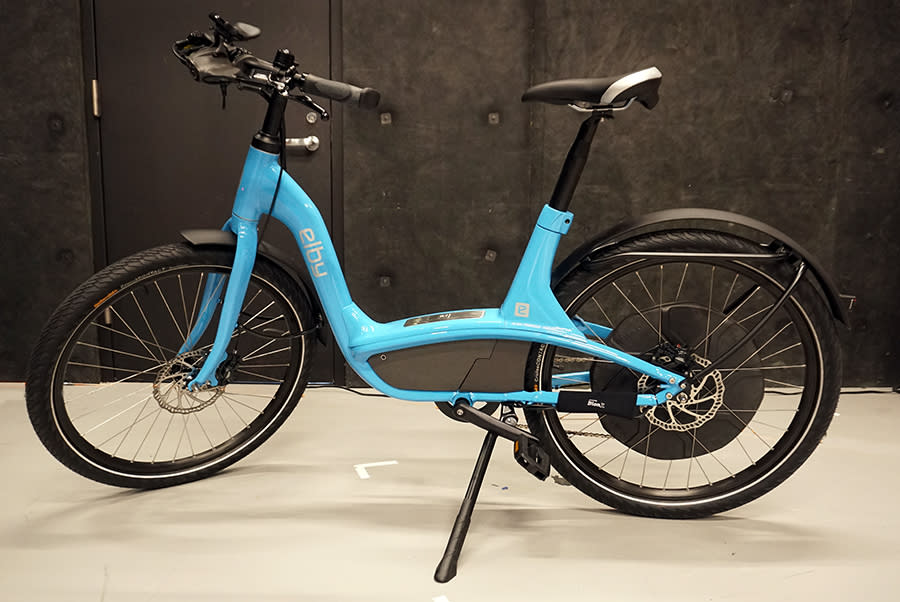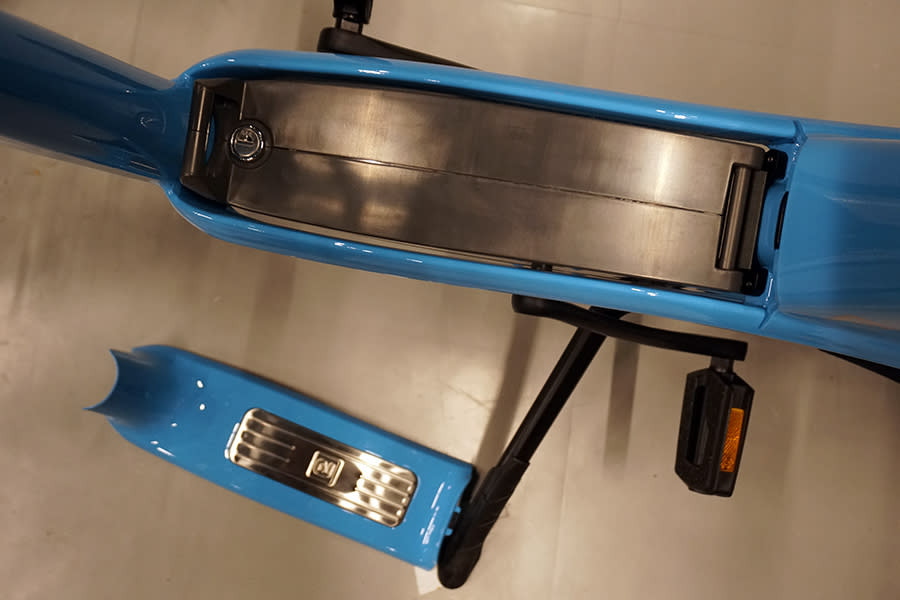My quest for the world's best e-bike
Last month I reviewed an e-bike for the first time: The Elby. (Short for “electric bicycle,” get it?) It was my first introduction to the world of pedal-assist electric bikes, and I was instantly smitten. I described this product category like this:
The electric motor on an e-bike basically amplifies the power of each pedal stroke, making easy work of hills and headwinds, getting you going faster, and giving you the chance to rest occasionally without slowing down.
Legally, an e-bike is a bicycle. So unlike a motorcycle, you don’t need a license, don’t have to be 16, don’t have to register it, don’t have to fuss with a bunch of laws. (Also unlike a motorcycle, you’re supposed to pedal most of the time.)
The good e-bikes seem surprisingly expensive—in the $3,500 range—until you consider how often you can commute or do errands on these things. Plenty of people can get away with an e-bike instead of a car (or instead of two $2.75 bus rides every day).
And, of course, you never have to pay for gas. You sail past traffic jams, and you never have to hunt for (or pay for) parking.
An e-bike makes biking cities and suburbs more practical, more desirable, more pleasant. As many e-bike owners can attest, an e-bike means that you can commute to work and arrive not sweaty.
I love the Elby. For many people, it could easily replace a car, or at least a second car.
But there are enough e-bike models to fill a transport ship, so I vowed that, before summer’s end, I would review a broader batch. And now, meet the broader batch!
(If you like, you can begin by watching my live unboxing video here.)
What they have in common
Turns out that $3,500 is a sweet spot of pricing for the really great e-bikes, the ones that are equipped with high-end bike parts and built to last, warrantied for 2 or 3 years. (You can, of course, get cheaper, uglier, and slower e-bikes. You can even get kits that retro-fit your existing bike to give it an electric boost.)
What distinguishes the bikes in this class are power, battery range, and, above all, design. These four bikes—from Trek, Faraday, Pedego, and Elby—could have been built by companies on four different planets.
Faraday Porteur
You’d swear that the Faraday Porteur is some European-designed import: Light and small, and with minimal clutter, no visible motor, bamboo fenders, classic steel frame, leather handgrips and seat. Wow, is this thing gorgeous.
They’ve actually hidden the battery inside the tube of the bike, so there’s really no visible sign that this thing is electric at all. The only giveaway might be the enclosed panel between the two horizontal tubes, where the circuit board (and power switch) reside.
Unlike the other bikes here, this one doesn’t even have a full-blown screen (only a battery gauge). There’s a thumb switch on the left handlebar that lets you choose one of two levels of power boost (plus Off).
There’s no throttle. The motor kicks in only when you’re actually pedaling. At that point, the boost is silent, gentle, solid, and incredibly smooth.
The Porteur has a Shimano internal 8-speed derailleur, which hides all of the sprockets and grease inside a cylinder on the rear wheel. Instead of a chain, your pedaling drives a greaseless, clean carbon belt that won’t mark up your pants.
There’s also a scissoring kickstand with two angled posts that hold the bike straight upright, but requires you to lift the back wheel each time you use it.
The Ideo-designed Porteur comes in white or green—in your choice of three frame sizes—and goes for $3,500. The $2,700 Porteur S costs less but loses some really nice features—like the internal derailleur, the leather, and the bamboo.
No wonder this bike was a Kickstarter success story. This is the bike for people who don’t want their bikes to scream, “Look at me! I’m electric!” Instead, it’s subtle. It’s a normal bike with a totally silent boost that kicks in gently when you pedal.
At 40 pounds, this bike is not nearly as heavy as its rivals. Shipping (fully assembled) is free, and there’s a two-year warranty.
There is, of course, a downside to all of this Spartan elegance: Minimal design means minimal performance. That thin tubular battery provides only 20 miles of assistance, with pedaling, which isn’t very much in the big picture. (Of course, you can always ride it without power once the battery is dead.) Top speed of the assistance system is 20 miles per hour. (On any e-bike, if you try to push beyond the top motor speed, the bike suddenly feels sluggish, like it wants to pull back.)
Meanwhile, the Porteur’s motor packs only 250 watts, with 350 watts at peak bursts. Worst of all, you can’t remove the battery to charge at your desk during the day; it charges only in the bike.
Trek XM700+
If the Faraday’s design is sweet and subtle, the Trek XM700+’s design is aggressive and militaristic. With its matte-black paint job, it looks like Batman’s e-bike.
The big news here is the top speed: 28 miles an hour, which Trek says is the fastest e-bike you can buy. That, in part, is because the Trek is a mid-drive bike, meaning the motor’s in the middle by the pedals, not on the wheel.
That design has advantages in torque, weight distribution, and, of course, speed—and it means that on the Trek, you can pop off either wheel with a quick-release lever. The disadvantages of mid-drive are noise and wear-and-tear, both on the gearbox and the chain.
The Trek ($3,500) comes with a cool, self-closing kickstand—just angle the leaning bike upright to make the kickstand snap up. There’s a nice chain guard to keep the smudges off your pants, and a shock absorber in the front fork.
The battery is removable, lockable, and chargeable at your desk, which is great. Unfortunately, it looks like it’s just been hot-glued to the bike, a really clumsy-looking design.
The screen is big and bright and clear. It can prompt you when it’s time to shift for best efficiency, and it shows you the remaining range of the battery, based on which of the four power levels you’ve chosen. Oh, and there’s a micro USB charging jack on that screen—so you can recharge your phone as you ride to work!
The Bosch motor offers 350 watts, and the battery offers 40 miles of range, with pedaling. Once again, there’s no throttle—you get electric boost only when you’re pedaling.
More details: Two-year warranty, reflective sidewalls, puncture-resistant tires, 10 gears, no rear light.
Pedego Classic Interceptor
When I assembled this bike ($3,500) on Facebook Live, commenters kept chiming in about how much they love their own Pedegos.
But I’ll come right out and say it: I was baffled by this bike. The beach-cruiser design feels huge and unwieldy. The handlebars are roughly 50 light-years apart, the shock-absorbent seat is wide and puffy, the balloon tires are fat, the weight is a vein-popping 60 pounds … all of this makes the Interceptor the 1977 Lincoln Continental of e-bikes.
Here again, the battery pack looks like an afterthought, shoved in the rat trap at the back, where its high, rear position isn’t great for weight balance.
Then again, it’s part of a great power system. You get 500 watts, top speed 20 miles an hour, with five assist levels, a big clear screen (with a phone charger!), and even a throttle, so you can get power without pedaling. Oh—and a three-year warranty.
I expect the squishy comfort and broad beam of this bike would make it great for long rides, cruising along the ocean or something. But it feels too ungainly for city use—especially if you have to haul that 60 pounds up to your third-floor walkup apartment.
Elby
You can read my full review here, but the gist is this: The Elby costs more than the others ($3,700), but it has everything. Much greater range than its rivals (90 miles with pedaling), more power (500 watts), a throttle and pedaling boost, a color screen (removable), USB jack for phone charging, front and back LED lights, an integrated battery that’s nonetheless lockable and removable (and chargeable at your desk), a step-through design without a top bar.
Oh, and regenerative braking, like a hybrid car: When you’re coasting, you can actually recharge your battery!
The downsides: The design looks more like something you’d ride to market than in the Tour de France. And the weight, 50 pounds, is daunting.
There’s a one-year warranty, although the motor/electronics system is covered for three years, and the frame and fork are covered for life.
Pedaling to the metal
Honestly, if you gave me any of these bikes for my birthday, I’d write you a 30-page thank-you letter. (Well, OK, if you gave me the Pedego, the letter would be about 6 pages long.)
But three of them in particular, designed for different uses, are truly spectacular.
The handsome Faraday Porteur, in size, weight, looks, and handling, is the most bike-like e-bike you can buy. Nobody will even suspect you’re getting a modest electric push, if only for 20 miles.
At the opposite extreme is the Elby, with more power and range than anything else on the market. It’s a brilliantly designed hybrid vehicle that’s a joy to ride, if not to carry upstairs.
In the middle, there’s the Trek XM700+, with its glowering looks and its nearly car-like speed—a dream machine for young commuters.
The main thing is to notice the arrival of truly useful e-bikes. If you’re not a fan of everything that makes today’s commuting and errand-running unpleasant—traffic, gasoline, pollution, parking, fees—then you should try an e-bike on for size, if only in your head.
David Pogue is the founder of Yahoo Tech; here’s how to get his columns by email. On the Web, he’s davidpogue.com. On Twitter, he’s @pogue. On email, he’s poguester@yahoo.com. He welcomes non-toxic comments in the Comments below.













